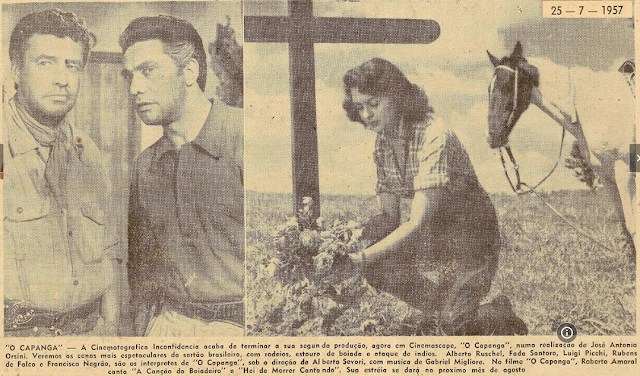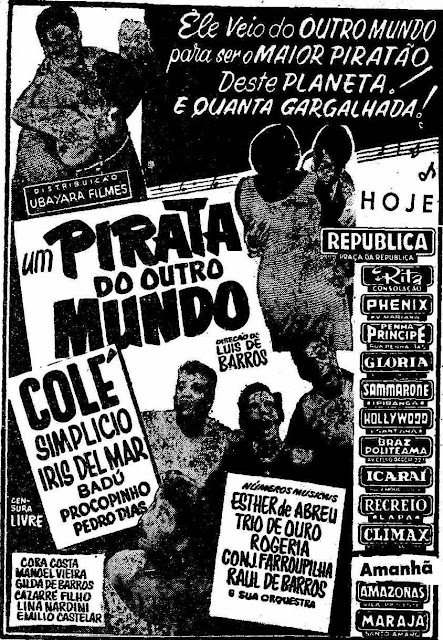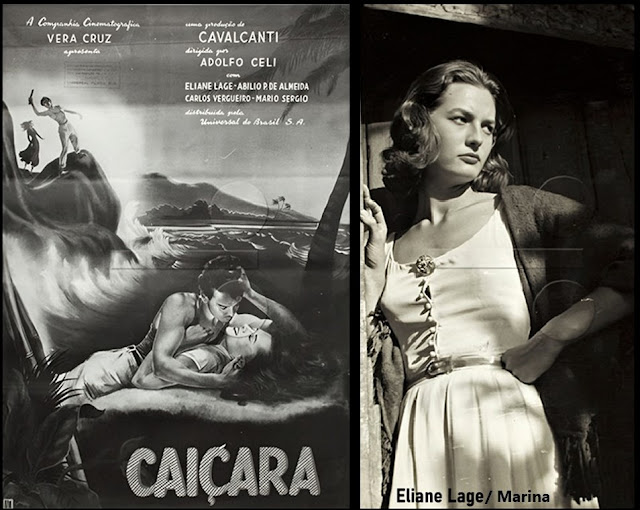10 August 1952 - brand-new Portuguese production of 1952 - 'Madragôa' reaches Rio de Janeiro first where - according to the ad - it was a big hit. A love story set in Madragoa, a popular district in Lisbon.
10 August 1952 - At Cine S.Bento: 'The great Missouri raid' (A vingança de Jesse James); 1950's 'Dark city' (Cidade negra) a firm noir in which Charlton Heston, future Moses & Ben Hur makes his debut in the movies; 1937 Republic serial: 'Zorro rides again' (A volta de El Zorro) completes the scene.
'A vingança de Jesse James' (The great Missouri raid).
Charlton Heston, Viveca Lindfors, Lizabeth Scott & Dean Jagger.
17 August 1952 - a 1948 production 'Serra Brava' is back at Cine Broadway, starring Leonor Maia & Antonio de Souza, directed by Armando Miranda who brought us 'Capas Negras' in 1947.
17 August 1952 - 'Mulher maldita' (Another man's poison') is Bette Davis follow up to 'All about Eve' that had brought her stardom back after a few year on the wane... and a brand-new husband Gary Merrill...
21 August 1952 - 'Mulher maldita' (Another man's poison) opens Cine Monark on 21 August 1952, located at Avenida Brigadeiro Luiz Antonio, 886. Cine Monark shut down shop circa 1965 and was rented by TV Tupi that used it as its downtown auditorium for a decade.
21 August 1952 - another brand-new cinema will open in Sao Paulo downtown area: Cine Joia at Pça.Carlos Gomes.
10 September 1952 - Vera Cruz kept on releasing good films. 'Appassionata' had Tonia Carrero divided between the charms of two leading hunks: Anselmo Duarte and Alberto Ruschel. See playwright Abilio Pereira de Almeida playing an actor's part.
Tonia Carrero & Anselmo Duarte.
Cine Joia inaugurates on 10 September 1952.
28 September 1952 - another movie house opens its doors to the public... Cine Roma, Rua da Mooca, 617 and Rua Placidina.
28 September 1952 - at S.Bento Johnny Weismüller is Junge Jim for the 4th time in 1950 'Captive girl' (Lagoa dos mortos) with former 'Flash Gordon' star Buster Crabbe & the Jungle Girl Anita Lhoest; child-actress Margaret O'Brien in 1951's 'Her first romance' (Idade da inocência); then 1943 Republic serial 'Secret Service in darkest Africa' (Adaga de Salomão) with Rod Cameron and Joan Marsh.
Anita Lhoest & a dangerous friend; Buster Crabbe in the Olympics in 1928.
Johnny Weissmüller in 1924; Kay Aldridge in 1942.
28 September 1952 -
12 October 1952 - yet another brand-new cinema house is opened in São Paulo: Cine Leblon, on Rua Vergueiro, 934, would show films produced by MGM. See the ad with cables congratulation Cine Leblon's inauguration received from the U.S.A. sent from such stars as Howard Keel, Stewart Granger, Deborah Kerr, Robert Taylor, Debbie Reynolds and Elizabeth Taylor.
12 October 1952 - David O.Selznick presents 'The 3rd man' (O 3o. homem) based on a Graham Greene novel. Haunting music provided by Anton Karas and his zither. Vera Cruz's 'Nadando em dinheiro' with Mazzaroppi would open on 27 October 1952.
9 November 1952 - Bibi Ferreira in Clemence Danes' 'Divorcio' at Teatro Colombo; Dercy Gonçalves in 'Paris de 1900' at Teatro Santana. Maria Antonieta Pons in the flesh at Cine Broadway with 'Maria Cristina'.
9 November 1952 - Walter Wanger's 1945 production 'Salome, where she danced' (A irresistivel Salomé) was Canadian bombshell Yvonne De Carlo's breakthrough at the silver screen.
1st December 1952 - Even though Cine Coliseu, in Santos-SP, premiered Alberto Cavalcanti's 'Simão, o caolho' on 12 January 1952, this comedy was first shown in São Paulo on the 1st day of December 1952. Alberto Cavalcanti directed Mesquitinha, Rachel Martins, Isaura Bruno, Carlos Araújo, Nair Bello, Gessy Fonseca & a great cast in a story based on chronicles written by Galeão Coutinho. gorgeous Yvonne De Carlo.
7 December 1952 - at Cine S.Bento double-feature: 1944's 'Berlim na batucada'; 1933's Laurel & Hardy's 'Desert sons' (Os filhos do deserto) and a Republic serial made in 1944 'O porto fantasma' (Haunted harbor) with Kane Richmond & Kay Aldridge who had been the star of 1942's 'The perils of Nyoka'.
Kay Aldridge in all kinds of perils in the 1944 serial 'Haunted harbor'.
7 December 1952 - a 1944 musical directed by Luiz de Barros, 'Berlim na batucada' is back on the silver-screen 8 years later due to Francisco Alves' automobile-crash and instant death on 27 September 1952, on the S.Paulo-Rio highway. Chico Viola's body was charred and greatly shocked the whole country. His weekly broadcast on midday Sunday at Radio Nacional was sadly missed and his songs were played non-stop for weeks. Brazil was in mourning for months...
21st December 1952 - Oscarito stars in 1946's 'Fantasma por acaso' with a very young Mary Gonçalves who would turn into a singer in the 1950s.






























.jpg)
.jpg)








.jpg)
















































